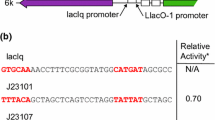Abstract
The activator-encoding gene phlR was identified upstream of the plasmid-encoded operon for phenol degradation in Pseudomonas putida strain H by cassette mutagenesis and DNA sequence analysis. The deduced amino acid sequence of PHLR shows high homology to DmpR of P. putida sp. CF600 and to the chromosomally encoded PhhR of P. putida P35X reported previously. Trans-activation of phenol degradation was observed when phlR was overexpressed in a phlR insertion mutant. Transconjugants of Escherichia coli carrying pPGH11, which contains the complete set of phl genes, are unable to grow on phenol as carbon source. However, two types of mutants were selected for further characterization that were able to metabolize phenol as sole source of carbon and energy. In both types of mutants enhanced expression of phlR is responsible for the Phl+ phenotype. In type I (pPGH13) a deletion of 1 bp made the −35 region and the spacing between the −35 and −10 regions of the phlR promoter more similar to the consensus structure. In type II (pPGH14) a duplication of the phlR 5′ region was identified that includes part of the −35 motif and reduces the spacing between the −35 and −10 regions. In addition, due to the duplication of part of phlR, the distance from the phlR promoter to the catabolic phl operon is increased. Different transcriptional start sites have been identified by primer extension analysis in clones harboring pPGH14 or the wild type phlR. Quantitative primer extension analysis revealed that the greatest amount of phlR transcript is expressed from the partial, phlR duplication. Growth on phenol and phenol hydroxylase activity reflect the high level of phlR transcript in E. coli transconjugants. Overexpression of PhlR was also observed when pPGH14 was transferred into P. putida, and results in earlier induction of the phenol degradation operon relative to the wild-type strain.
Similar content being viewed by others
Author information
Authors and Affiliations
Additional information
Received: 25 September 1996 / Accepted: 10 December 1996
Rights and permissions
About this article
Cite this article
Burchhardt, G., Schmidt, I., Cuypers, H. et al. Studies on spontanous promoter-up mutations in the transcriptional activator-encoding gene phlR and their effects on the degradation of phenol in Escherichia coli and Pseudomonas putida . Mol Gen Genet 254, 539–547 (1997). https://doi.org/10.1007/s004380050449
Issue Date:
DOI: https://doi.org/10.1007/s004380050449




